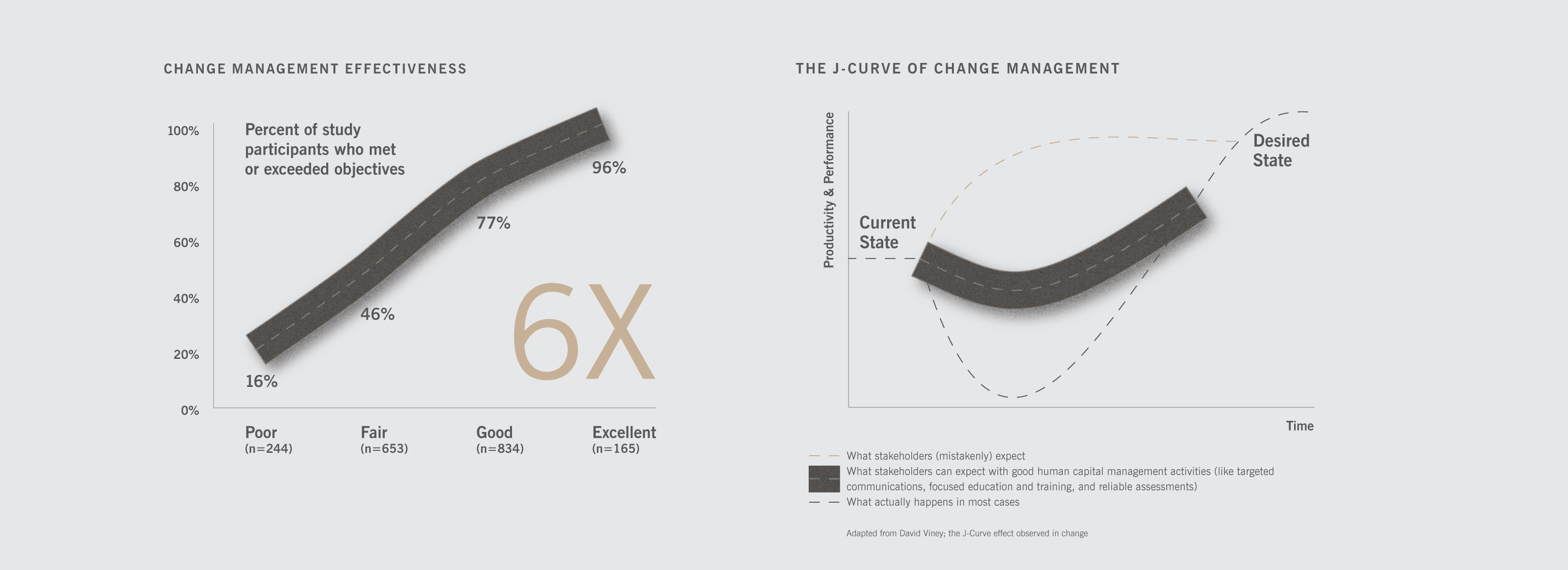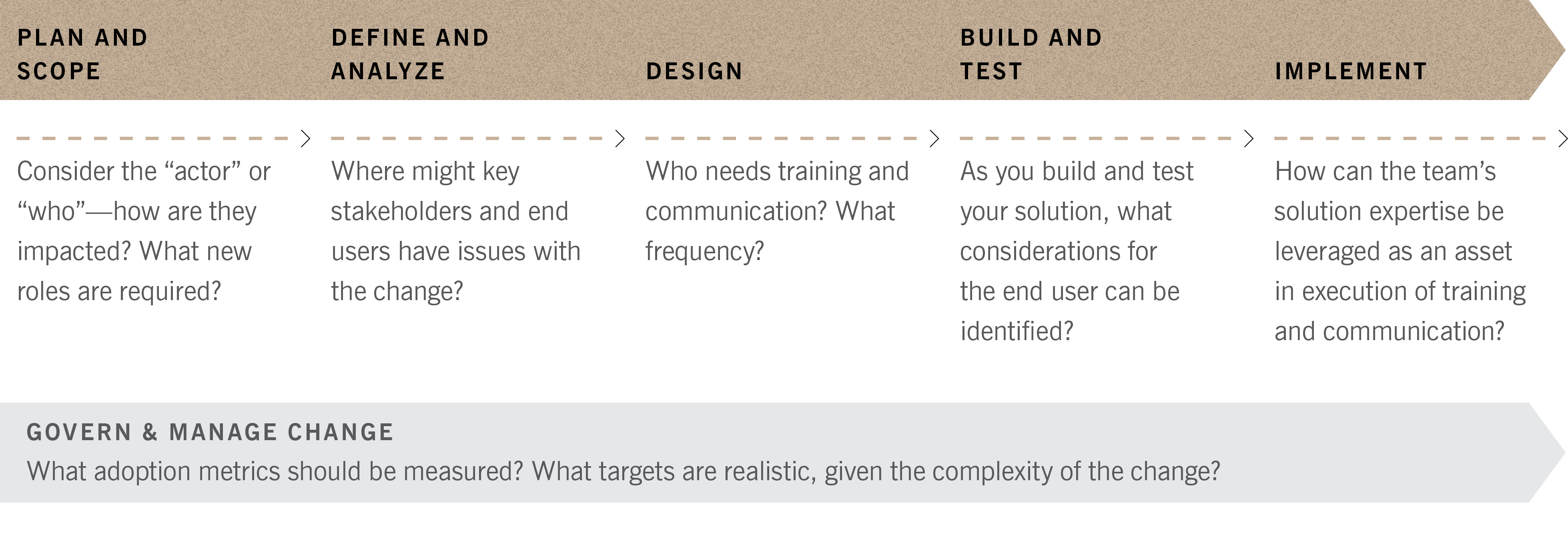A month rolls by, then a quarter, then six months, and the numbers come out. Adoption is low. Results are disappointing. The original business case is unrealized. Everyone agrees the solution is fantastic and the deployment went flawlessly. You’ve raced your car to the end of the course but failed to cross the line and see the checkered flag wave. So, what happened? What was missing?
Often, teams follow a project methodology, use best practices, and enlist skilled practitioners. But even these well-intentioned organizations miss the mark when they overlook the human factor. Did the project team consider people before designing the program, process, or technology? In the effort to design the most innovative or transformative solution (the shiniest new race car), the new solution’s impact on its end users, key stakeholders, and executives was missed. Without hitting the stops along the race route, refueling, and engaging your pit crew and coaches, your race is at risk of being much less successful—and that’s if you have enough gas and resources to make it across the finish line at all. To avoid this potential gap, project teams must foster a culture that is supportive of the use of human capital management strategies and tools throughout the course of a project life cycle.
What is Human Capital Management?
Human capital management aligns the goals and objectives of the organization to the needs and aspirations of its people. HCM can structure an organization, develop its people, create leaders, raise performance, create an environment where people excel, and lead change. In application, HCM translates to considering the people side of business—their roles and responsibilities, how they are trained, what communication they receive, and how they adapt to change.
Focusing on HCM as a strategic imperative early in a project’s life cycle can ensure the success of any major transformation within an organization. For example, clearly defining roles and responsibilities and communicating those definitions effectively can drive employee understanding, leading to effectiveness of and satisfaction with the change. Designing a new technology solution to best meet the end user’s needs will ensure the most value is created. Creating effective training and communication for a new technology solution can drive adoption. In all cases, HCM is the key link to ensuring the successful implementation and long-term adoption of any strategic transformation.
According to Prosci best practices in change management, projects with effective change management were five to six times more successful than projects that overlooked or ignored it. There is significant risk to project benefits, both financial and organizational, if the changes are not implemented effectively and adopted as expected. The J-Curve of Change Management illustrates expected results when implementing change versus actual returns, which prove to be much more disruptive when HCM is not implemented. Managing change decreases the negative impact on productivity and performance of the impacted audience as they continue on the journey to the desired state.
Structuring the team for HCM Success
To create a project team that has a human capital management perspective throughout the engagement, identify and involve people with the right skills from the beginning. If HCM is the gas that fuels your race car engine, the project team is your coaches, pit crew, and support that gets you through the course. A key resource that can provide the link between HCM and the solution design is the business analyst.
The business analyst is a knowledgeable resource who can align strategic objectives to products, operations, customers, and/or technologies. BAs who know the solution, the business needs, and requirements have a foundational knowledge of a project. They have already built relationships with various stakeholders. Train BAs to incorporate change management and think like a human capital management expert, and the project will reap the benefits organically, including improved integration, better connection to business needs, and ultimately an improved end-user experience.
There are two models for combining the BA and HCM skill sets that set up the engagement for HCM success.
(1) Partnership/Tight Integration.
This model requires two resource types—BA and HCM resources—who maintain a tight partnership. Both resource types need to be involved in key meetings that define the scope of the transformation. They must have a good understanding of the move from what is to what will be. While it may seem inefficient to allocate two resource types, this approach allows a more focused use of resources, which is especially helpful in major transformative programs. The combined perspectives of HCM and business analysis provide the optimum lens to compare current state versus future state tools, processes, roles, and responsibilities.
(2) Super BA.
This model requires having a single resource type who is not only able to understand and define the functional requirements, but who can also identify and drive nonfunctional requirements such as success factors for user experience, change management, training, etc. These skills can be difficult to find. They require both technical/solution-specific knowledge and the acumen to assess what the change means from a people perspective. Additionally, if the scope of the program is significant, this may lead to a bottleneck and may be better suited for smaller or more focused initiatives around specific product improvements or change requests.Note: The number of resources will vary based on size and scope of the project.
No matter which model you choose, it is important to encourage all project resources to own the goal of incorporating human capital into their work. Ensure the team has exposure to and is aware of key HCM principles and basic skills. Determine if this mindset shift will have an impact on any of the team’s roles or day-to-day responsibilities. To avoid resistance or the “that’s not my job” mentality, ensure there is leadership buy-in and prioritization to affect change in the culture of the team.
Incorporating HCM into the Delivery Life cycle
In all engagements, leaders can insert human capital management at clear entry points to increase success. These entry points are like the pit stops along a racecourse, where cars are refueled, readjusted, and prepped to continue toward the finish line. There is a tendency to tack human capital management on at the end, but incorporating these elements into the entire process adds far more value. When HCM is not looked at as an afterthought, leaders have the opportunity to identify where change will affect the business earlier in the timeline and better manage that change throughout the process.
Plan and Scope
HCM should be included as a strategic component from day one of any project, beginning with planning and scoping.
- Connect project goals to key HCM principles, showing how strategic change management thinking can help accomplish the end goal.
- Involve the right stakeholders to govern the project. These resources can also act as change agents and champions through later phases.
- Determine the appropriate HCM tools and activities to build into the project plan. These deliverables can be used to capture valuable details from each stakeholder group.
- Evaluate the readiness of the organization to absorb the change based on the solution complexity.
- Consider the projected level of complexity and resistance to change, which will drive the amount of time and effort required from management to ensure successful adoption.
Define and Design
- Incorporate change management principles into the requirements-gathering process by considering the people behind each action.
- Define nonfunctional requirements for training, communication,
and metrics. - Identify potential issues and foresee where a lack of adoption might occur. Think of how your users will view the solution. Begin asking questions such as “How can we make it stick?” and “What must we do to succeed?”
- Begin building core human capital management deliverables, which may include:
- Impact Assessment:A tool used to highlight who will use the new solution and how they will be impacted by it.
- Business Scenarios:A tool used to highlight what business activities are incorporated into the new solution, including the actor or person performing each task.
- Communication Plan:A tool used to map out detailed communication touchpoints, including stakeholders, effects, and recommended channels for both communication and training.
Build and Test
- Identify impacts of decisions made during the build phase on the training and communication content. Considering these impacts early will reduce the level of effort to prepare.
- Engage business analysts in training development and delivery to provide context on the system requirements and functionality. Training can be more effective with the involvement of someone who knows the “why.”
- Ensure training is timely and conducted by the resources who are knowledgeable and can champion the change.
- Encourage developers and testers to put themselves in the shoes of an end user and ensure their perspective is considered.
- Incorporate feedback from the testing teams into the communication strategy.
- Execute human capital management planning tools, engaging the perspective of the whole project team as the solution is finalized.
Implement and Govern
- Measure key metrics following deployment, ensuring realistic targets for adoption and benefit realization over time, given the complexity of the change.
- Enable project leadership and key stakeholders to act as change agents and champion the new solution.
- Adjust (add, update, retract) communications and training strategies as implementation continues and additional needs or complexities are identified.
HCM as a Long-Term Success Strategy
By applying human capital management practices, the same team that was feeling dejected post-implementation will instead have the confidence to engage and rally around the project goals. The team is prepared to tap into their expertise and use it to enhance productivity. The same team that was left behind as you tried to race on your own is now actively changing tires, refueling, shouting instructions, and getting you across the finish line with more speed and success.
In their next engagement, team members can focus on the human factor to stimulate adoption and a successful transformation. Project leadership will not be left wondering why they couldn’t make the change stick. Instead, they will conclude their next initiative with a successfully implemented plan, using a team that included people-focused practices every turn of the course.


